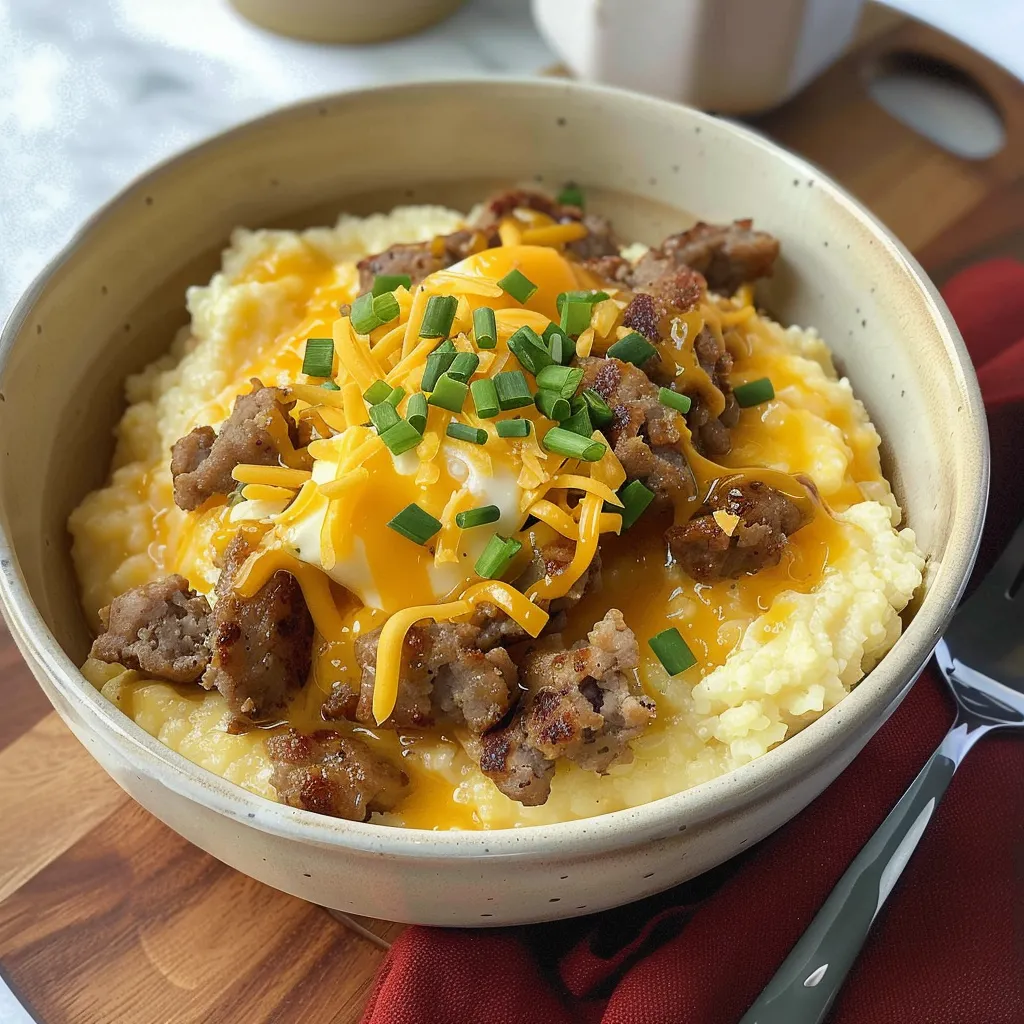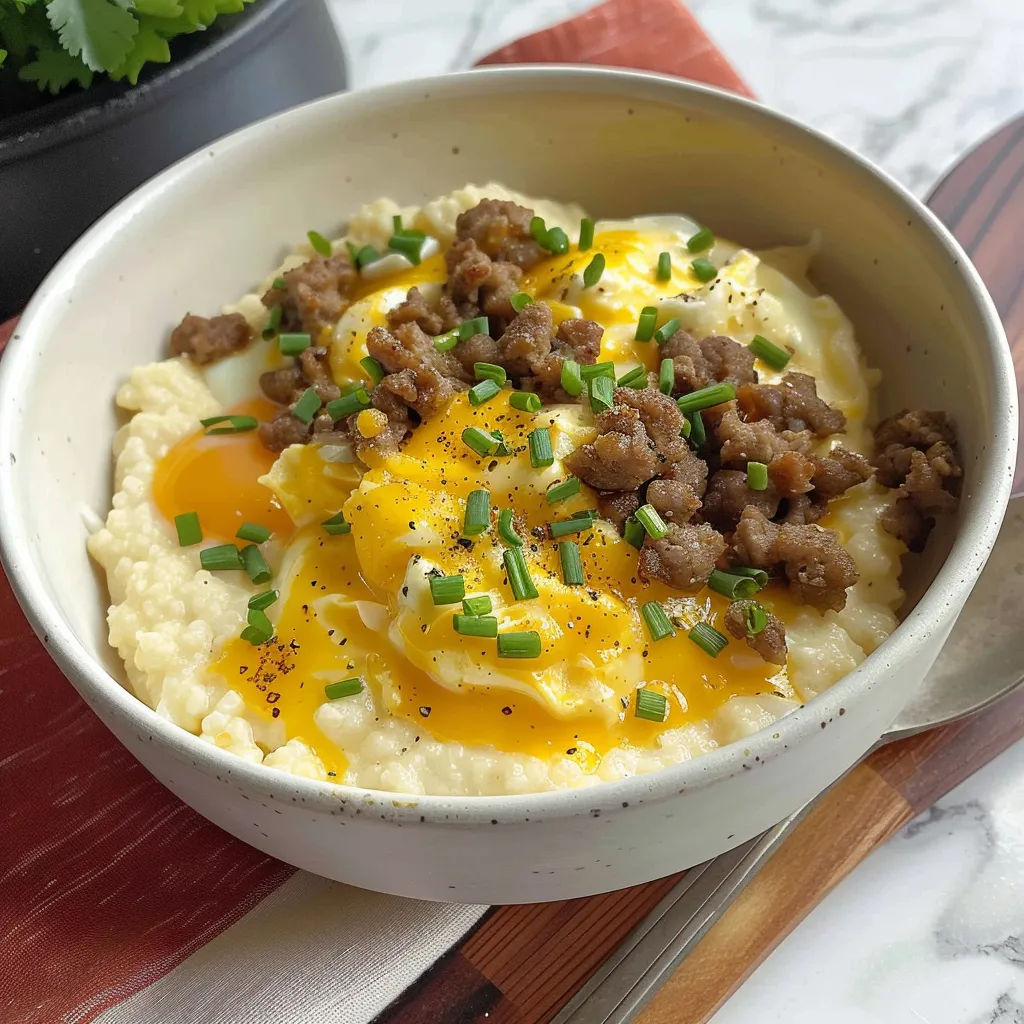 Pin it
Pin it
This cheesy Southern grits breakfast bowl transforms humble ingredients into a comforting morning meal that will keep you satisfied for hours. The combination of creamy, cheese-laden grits topped with savory sausage and fluffy scrambled eggs creates the perfect balance of flavors and textures in every bite.
I first made these grits bowls when hosting friends from out of town, and now they request this dish every time they visit. There's something magical about the way the cheese melts into the hot grits, creating pockets of gooey goodness throughout.
Ingredients
- Whole milk: Provides richness and creaminess that makes these grits extra luxurious
- Water: Helps achieve the perfect consistency without making the grits too heavy
- Salt: Enhances all the flavors and is crucial for properly seasoned grits
- Stone ground grits: Offer authentic texture and flavor regular quick grits simply cannot match
- Black pepper: Adds a subtle heat that balances the creaminess
- Unsalted butter: Creates silky richness and allows you to control the salt level
- Sharp cheddar cheese: Brings bold flavor that stands up to the hearty grits
- Large eggs: Provide protein and a fluffy contrast to the dense grits
- Breakfast sausage: Adds savory depth and makes this a complete meal
- Fresh chives: Bring a bright pop of color and mild onion flavor to finish the dish
Step-by-Step Instructions
- Prepare the liquid base:
- Combine milk, water, and salt in a medium saucepan over medium heat and bring to a gentle boil. This combination creates the perfect richness without being too heavy. Watch carefully as milk can quickly boil over.
- Add the grits:
- Once boiling, slowly whisk in the grits in a steady stream while continuously stirring. This gradual addition prevents lumps from forming and ensures even cooking. Take your time with this step.
- Simmer to perfection:
- Reduce heat to medium-low, cover, and cook for about 20 minutes, whisking frequently every few minutes. The grits will gradually thicken and absorb the liquid. If they become too thick or start sticking, add a splash of water and reduce heat further. The grits are done when they're creamy with no gritty texture when tasted.
- Finish with flavor:
- Remove the pan from heat and immediately stir in pepper, butter, and shredded cheese. The residual heat will melt everything into a velvety consistency. Cover the pot to keep warm while preparing the toppings.
- Cook the sausage:
- While the grits are cooking, heat a nonstick skillet over medium heat. Break the sausage into small pieces directly in the pan. Cook until thoroughly browned, about 6-8 minutes, turning occasionally. The smaller pieces create more surface area for browning, which equals more flavor.
- Prepare the eggs:
- After removing the cooked sausage, leave just a tablespoon of the flavorful grease in the pan. Whisk eggs in a bowl until fully combined, then pour into the warm skillet over medium-low heat. The lower temperature prevents tough, overcooked eggs.
- Create perfect scrambled eggs:
- As the eggs begin to set on the bottom of the pan, gently pull them across with a spatula, creating soft folds of egg curds. Continue this gentle folding motion until eggs are just set but still appear slightly moist. They will continue cooking from residual heat.
- Assemble your bowls:
- Divide the hot cheesy grits between four bowls, creating a base for your toppings. Layer on the sausage crumbles and scrambled eggs. For extra indulgence, sprinkle additional cheese on top, which will melt from the heat of the ingredients below.
 Pin it
Pin it
My grandmother always insisted on stone-ground grits, claiming they connected us to our Southern heritage more authentically than any quick-cooking version. After years of making this recipe, I can confidently say she was right. The texture and flavor simply cannot be matched.
Make-Ahead Options
These grits bowls can be partially prepared in advance to make mornings easier. Cook the grits the night before and refrigerate them in an airtight container. In the morning, reheat them slowly on the stovetop with a splash of milk to restore their creamy texture, then prepare the toppings fresh. The reheated grits might need an extra tablespoon of butter to bring back their silky consistency.
Delicious Variations
While this classic version is delicious, feel free to customize your grits bowl based on what you have available. Try crumbled bacon instead of sausage, or add sautéed bell peppers and onions for extra vegetables. For a spicy kick, stir in diced jalapeños or a dash of hot sauce. Vegetarians can omit the meat entirely and top with roasted vegetables and a fried egg instead of scrambled.
Serving Suggestions
These grits bowls are hearty enough to serve on their own, but they also pair beautifully with fresh fruit or a light green salad for brunch. For a more indulgent meal, serve alongside buttermilk biscuits or thick slices of buttered toast. A small glass of tomato juice or a light mimosa completes the experience for weekend entertaining.
The History of Grits
Grits have been a staple in Southern cuisine for centuries, with their origins tracing back to Native American corn preparations. The word "grits" comes from the Old English word "grytt," meaning a coarse meal. Traditional stone-ground grits maintain much of the corn hull and germ, preserving nutrients and flavor that are often lost in highly processed varieties. This breakfast bowl represents the evolution of grits from a simple porridge to a versatile base for flavorful toppings.
Frequently Asked Questions
- → How do I keep the grits from sticking to the pan?
Stir frequently and reduce the heat if they start to stick. Adding a splash of water helps too.
- → Can I use instant grits instead of stone-ground?
Yes, but the texture will be different. Instant grits cook faster but lack the creaminess of stone-ground grits.
- → What can I use instead of breakfast sausage?
Try bacon, ham, or even a plant-based sausage alternative for variety.
- → Can I make this ahead of time?
You can prepare the grits and sausage ahead, but make the scrambled eggs fresh for the best texture.
- → What alternatives work for sharp cheddar?
Other cheeses like gouda, parmesan, or Monterey jack can be great substitutes.
